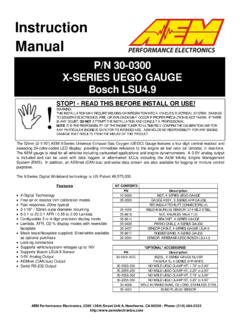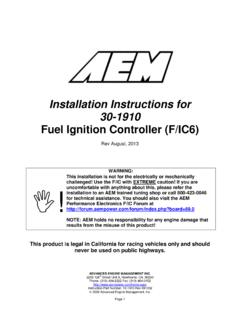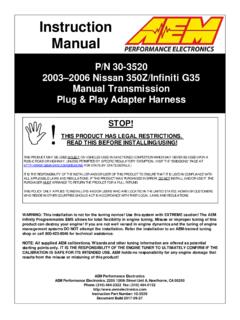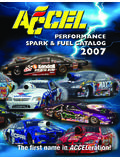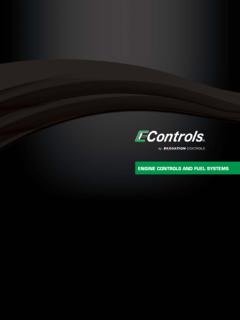Transcription of Installation Instructions for 30-4110 Gauge-Type …
1 ADVANCED ENGINE MANAGEMENT INC. 2205 126th Street Unit A, Hawthorne, CA. 90250 Phone: (310) 484-2322 Fax: (310) 484-0152 Instruction Part Number: 10-4110 Rev 140520 2014 Advanced Engine Management, Inc. Page 1 Installation Instructions for 30-4110 Gauge-Type uego Controller WARNING: !This Installation is not for the electrically or mechanically challenged! Use this sensor with EXTREME caution! If you are uncomfortable with anything about this, please refer the Installation to an AEM trained tuning shop or call 800-423-0046 for technical assistance.
2 You should also visit the AEM Performance Electronics Forum at NOTE: AEM holds no responsibility for any engine damage that results from the misuse of this product! This product is legal in California for racing vehicles only and should never be used on public highways. Page 2 AEM Gauge-Type uego Controller Parts 1 x uego gauge Assembly 1 x uego Sensor 1 x O2 Sensor Bung 4 x Butt Connectors 1 x Installation Instruction 1 x 4 Lead Harness 1 x uego Sensor Harness 1 x Silver Bezel 1 x Black Lambda Faceplate 1 x White AFR Faceplate Replacement Wideband Controller Components 30-2004 Replacement Bosch LSU49 Sensor 35-3441 96 Wideband LSU49 uego Sensor Replacement Cable 35-3401 36 Wideband uego Power Replacement Cable 35-4005 Mild Steel
3 Oxygen Sensor Bung (welding required) 35-4001 Mild Steel Sensor Bung Plug 30-4008 Stainless Steel Tall Finned Oxygen Sensor Bung (welding required) Congratulations! The 52mm (2-1/16 ) AEM Universal Exhaust Gas Oxygen ( uego ) gauge features a digital readout and sweeping 24 color-coded light emitting diode (LED) display, providing immediate reference to the engine air fuel ratio (or lambda) in real-time. The AEM gauge is ideal for all vehicles including carbureted applications and engine dynamometers.
4 A user-selectable 0-5V analog output is included and can be used with data loggers as well as most Electronic Fuel Injection (EFI) systems including the AEM Engine Management System (EMS). A serial data stream is also integrated for air fuel (or lambda) ratio output to a RS-232 com port. Because the AEM gauge utilizes the internal AEM uego controller and Bosch uego Sensor, it is accurate and repeatable to of an air/fuel ratio point! With this, there is no abrupt oscillation as found in many competitor gauges, which utilize a narrow band oxygen sensor detecting only stoichiometry.
5 Page 3 Typical production vehicle oxygen sensors rely on Nernst Cell technology, commonly called Narrow Band and sometimes erroneously described as Wide Band . This is a very cost effective method that outputs a voltage based on the oxygen content of the gas being sampled. It is accurate in the region surrounding stoichiometric operation and leaner. Unfortunately, in the rich region where high performance engines usually operate, their accuracy and repeatability is virtually non-existent.
6 (Figure 1) Figure 1. Characteristic curve of a Nernst Cell O2 Sensor The rich region output of narrow band O2 sensors is temperature dependent, which renders it useless if an accuracy better than :1 AFR is desired. This is immediately obvious given the fact that a single output voltage actually represents wildly different air fuel ratios depending on the unregulated and unmeasured sensor temperature. These sensors were designed for operating closed loop around stoichiometry ( :1 for gasoline), and for performance tuning they are useless.
7 The heart of the AEM gauge is the Bosch Universal Exhaust Gas Oxygen ( uego ) sensor. This type of sensor is commonly referred to as laboratory grade and works on a different principle than the narrow band oxygen sensor found in most vehicles. Its unique design makes precision AFR measurements possible over the entire operating range. uego sensors use a current pump to determine the actual oxygen concentration within the sensing element.
8 The output is in the form of a very small current, which varies depending on the air-fuel ratio. This is completely different from a narrow band oxygen sensor, which directly outputs a voltage. The uego sensor design allows measurement of the exact air fuel ratio over the entire operating range. Page 4 Each AEM uego sensor is individually calibrated and a resistor integral at the connector body is laser trimmed with this value. This process replaces the free air calibration procedure required by some manufacturers when changing sensors and implements a sensor specific calibration for unparalleled accuracy.
9 (Figure 2) Figure 2. The connector module contains a laser trimmed calibration resistor, which defines the characteristic of the sensor. Installation Disconnect the negative (-) battery cable. There are two harnesses that connect to the back of the AEM uego gauge . The longer harness connects to the uego sensor. The shorter harness contains four leads. The red and black leads must be connected in order for the gauge to function. Connection of the white and blue wires is optional.
10 Connect the wires as shown below. (Figure 3) The harness ends with the four and six pin connectors connect to the back of the gauge . When looking at the back of the gauge as shown below, the six-pin connector connects on the left side and the four pin on the right side. The locating tabs on the four and six pin connectors should be facing up. (Figure 4) Figure 3. gauge Installation Connections Page 5 Figure 4. gauge Side Harness Connections RED <Power> Connect to a switched 10-18 volt power source utilizing a 10A fuse.
